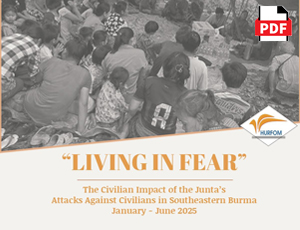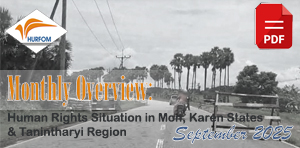SPDC Battalion uses forced porters as human shield against land mines and further attack
August 24, 2010
HURFOM, Kyarinnseikyi: As a consequence of the increasing skirmishes between SPDC and KNLA forces in the southern part of Karen State, villagers have been subjected to several incidents of forced portering by SPDC units. After several engagements, villagers were pressed into portering service by SPDC soldiers in apparent retribution for the KNLA assaults. In multiple instances these civilian porters were intentionally used by SPDC as human shields to protect the advancing columns from additional assaults or the presence of landmines along the road.
On the morning of August 3rd, Light Infantry Battalion (LIB) No. 406’s, military column No.1 was ambushed by the Karen National Union’s (KNU’s) Karen National Liberation Army (KNLA) Battalion No. 17 for one hour between Khoe Htoo village and Kamar Khalae village, situated between Azinn – sub-township of Kyikedon, and Kyikedon Township, Karen State. During that battle, two soldiers from SPDC LIB No. 406 were killed and five were injured. According to a sergeant from KNLA Battalion No.17, the SPDC also lost 250 rounds of a MA-4 rifle, and a 2 way radio in that battle, which were sized by the KNLA.
Since July tension in the area has increased as the Democratic Karen Buddhist Army (DKBA), originally split from the KNU, and nominally allied with the SPDC, has divided over the issue of the border guard force (BGF). Saw Law Bwe (also known as Na Kham Mwe), the commander of DKBA Brigade No. 5, having split from the remaining pro-SPDC DKBA factions, is rumored to have aligned himself with the KNLA, prompting an increased presence of SPDC soldiers. Additionally, the SPDC has appeared to conduct more aggressive patrols and action in the area to apply pressure to New Mon State Party (NMSP), which has also resisted submitting its armed wing, the Mon National Liberation Army (MNLA) to become a BGF.
After the August 3rd engagement, LIB No. 406 arrived in Kamar Khalae and detained 3 residents for portering. Then on the 7th, the battalion arrived in Numbat Chaung and Khoke Khwar, forceing another 30 men and women into portering service. The residents were forced to carry the injured troops, weapons and rations 36 miles to Tagay village.
A 43-year-old female cultivator from Khoe Htoo village, who preferred to remain anonymous, told a HURFOM field reporter that she had seen the 3 detained villagers walking ahead of the column, carrying supplies:
In the battle near Kamar Khalae village, they [SPDC soldiers] were killed. [The injured soldiers] were not carried to the hospital of Kyikedon sub-township. [However] the hospital couldn’t treat [the wounded soldiers, so they crossed Palaw Phathaw village which is near by ours [to transport the injured troops] and detained at least three villagers during their trip [to use as porters]. The main reason they did this was that they were afraid of the KNU. The shells of the heavy weapons were put in the baskets and these three persons were forced to carry them and to go ahead. If there was a battle, they would be use as the cover and if there were landmines, they would step on the mines. I saw their group while I was working on my farm. At the time it was the afternoon of August 5th, I think.
According to the locals, the detention of three residents to be used as porters is not the only instance of this abuse as a result of the KNLA and LIB No. 406 battle. In Numbat Chaung and Khoke Khwar villages which are situated in the east part of Kyarinnseikyi Township, a group of 30 men and women were also detained and forced to sever as porters.
Saw Kho Kho, 32, was staying at his farm when he witnessed the 30 people who were arrested as porters by LIB No. 406, walking in front of the Burmese troops near his farm in Khoke Khwar village near Khoke Khwar village:
[A total of] 30 people were arrested both from Khoke Khwar and Numbat Chaung village [normally containing only 40?]. We got the exact list from the headman. Women were also included [in portering]. I am quite worried about them. Usually only men have to be involved in portering. If women are also involved [in portering], they are unsafe [the implication being that in similar circumstances, women porters have been subjected to sexual assault and rape in the past]. They [Burmese soldiers] were not only injured but also killed in the action. They also lost some weapons, so, I think, they arrested the innocent Karen civilians and forced them to work, in order to inflict punishment on the Karen people. I didn’t dare follow [the column], so I don’t know where these people were forced to go to. According to my neighbor who saw the event while he was collecting bamboo shoots, [they] had to carry some rice bags, bullets, nose caps of heavy-weapon [ordinance] and the patients [injured Burmese soldiers].
The names of the people who had been pressed into forced portering service were collected by Saw Lar Doe and Saw Bate, who after having been forced to work as porters using their cars, were released on their arrival at the columns destination of Tagay village on August 16th.
Saw Lar Doe described to HURFOM’s field reporter his experience portering, and a list of the names and ages of other victims:
On the morning of August 7th, on their return from Numbat Chaung village, Burmese army LIB No. 406 called to our two carts [to be used as porters]. I, Saw Lar Doe, am 26 and Saw Bate is 13. Saw Bate is just a teenager. The people who had to accompany with the army column were [3 men*].
On the same day the army column arrived at Khoke Khwar village and collected villagers again. As I could tell, the people who were collected by the army [were 17 men and 5 women*].
Three Mingalar Gone [all men*] residents who came to Khoke Khwar village to purchase durian fruits are were they forced to porter too.
These villagers had to escort the army column to Tagay village. We had to carry [the heavy weapon ordnance] with our carts. The porters were forced to go ahead. We were allowed to go back as soon as we arrived Tagay village, and I think that was because we two, are the cart-owners.
Despite the KNLA’s frequent use of guerrilla warfare to engage SPDC forces due to their strength in numbers, SPDC army units in KNU/KNLA territory are at times avoided due to the SPDC army’s use of civilians as human shields against gunfire and landmines, in addition to portering, according to a KNLA Captain from Battalion No. 17. Another KNLA captain who is authorized to comment on KNLA fighting, responded on phone with HURFOM field reports that if the SPDC bore a grudge against civilians who are frequently assumed to be insurgent-supporters, and punish or take revenge on them, the civil war would never end.
The increase in fighting between KNLA and SPDC forces posses a significant risk for local residents who, though not directly engaged in fighting, are frequently targeted by Burmese army units. In this instance, while villagers eventually returned to their villages without suffering casualties, they did face frequent verbal abuse and harassment. Moreover it is important to note that by using villagers as shields against attack or to warn of landmines by their trigging them with their bodies, LIB No. 406 is increasing the very really likelihood of civilians becoming victims of this continued conflict.
*For security purposes the names of interviewed villagers have been changed, and the list of names and ages of portering victims has been removed. The full list of victims’ names and ages can be made available upon request.
Comments
Got something to say?
You must be logged in to post a comment.



















































